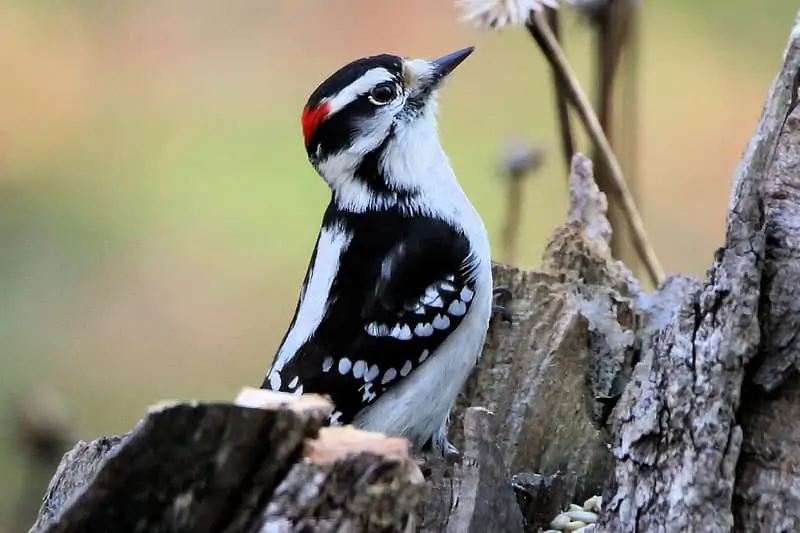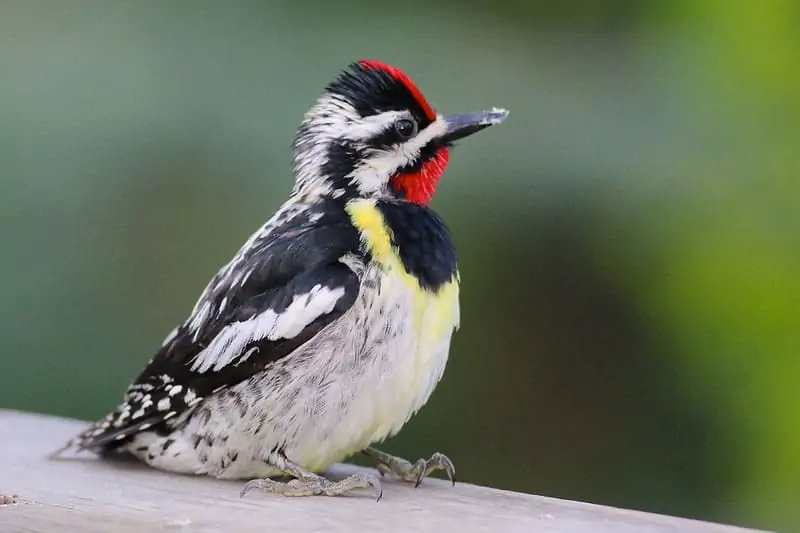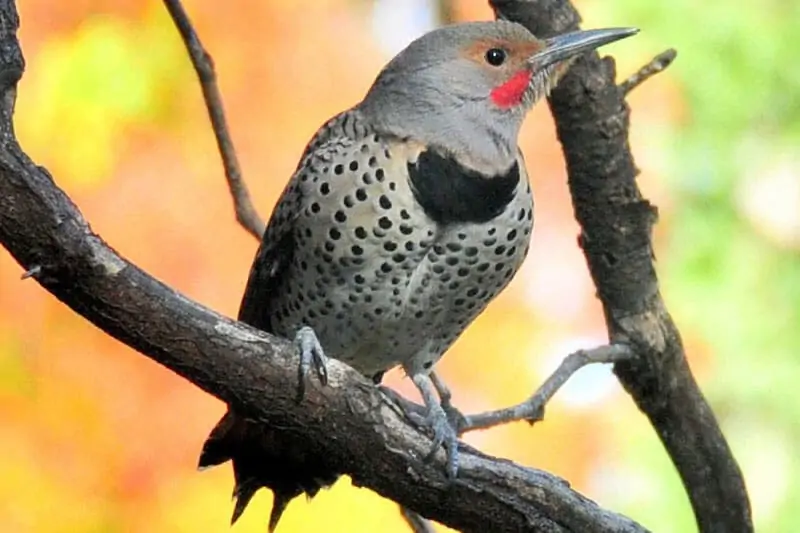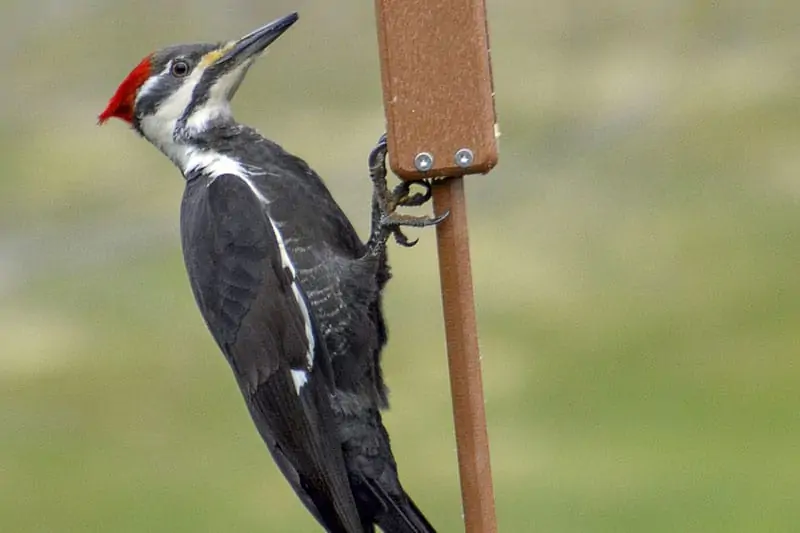Kansas’ central position and moderate climate allow for a wide variety of creatures to thrive in the state, with an total area of well over 82,277 square miles made up mostly of vast plains. We’ll learn about each of the eight species of woodpeckers in Kansas in this article, which includes many different kinds of birds.
I’ll go over the species one by one, giving you information on where and when you can see them in Kansas. We’ll also discuss some interesting woodpecker facts and provide you with photos of each species to help you differentiate them.
WOODPECKERS IN KANSAS
Red-bellied Woodpecker, Red-headed Woodpecker, Downy Woodpecker, Yellow-bellied Sapsucker, Ladder-backed Woodpecker, Hairy Woodpecker, Northern Flicker are the eight species of woodpickers found in Kansas.
1. RED-BELLIED WOODPECKER

Length: 9.4 in
Weight: 2.0-3.2 oz
Wingspan: 13.0 -16.5 in
The caps and napes of red-bellied woodpeckers are bright red, with black and white stripes on the backs. These woodpeckers may be seen perched on the main branches and trunks of trees all year round in Kansas’ woodlands and backyards.
They’re also known for leaving the woods to go to backyard bird feeders. During the winter, use suet blocks to attract them, as well as peanuts and sunflower seeds. The insects inside dead trees are also appealing to them.
Learning the loud, rolling call of one of these birds is one of the best ways to find them. In the spring and summer, they are quite talkative callers, so pay attention during those times.
2. RED-HEADED WOODPECKER

Length: 7.5-9.1 in
Weight: 2.0-3.2 oz
Wingspan: 16.5 in
Throughout East Kansas, red-headed woodpeckers may be found all year, however the western half of the state is only home to them during breeding season. Adults have black and white wings that make them immediately identifiable, as well as bright red heads. The plumage of juveniles is substantially gray-brown, with white patches on their wings. They are less colorful.
Open woodlands with clear understory, pine savannas, and swamps are preferred habitats for these woodpeckers. Their population is declining as a result of habitat loss.
In comparison to other woodpeckers, they are unusual. In addition to drilling into wood, Red-headed Woodpeckers hunt for insects in the air. In their tree crevices, they also keep excess food like nuts and seeds.
3. DOWNY WOODPECKER

Length: 5.5-6.7 in
Weight: 0.7-1.0 oz
Wingspan: 9.8-11.8 in
Compared to other woodpeckers, Downy Woodpeckers are tiny. They range in size from small sparrows to big robins. In addition, their beaks look smaller than the rest of the woodpeckers’.
In Kansas, year-round, you may find Downy Woodpeckers in open woodlands and forests. They may be found in backyards, parks, and other residential regions, preferring deciduous trees. They hammer into trees and create their distinctive high-pitched calls throughout the spring and summer.
4. YELLOW-BELLIED SAPSUCKER

Length: 7.1-8.7 in
Weight: 1.5-1.9 oz
Wingspan: 13.4-15.8 in
Yellow-bellied Sapsuckers have a winter population that breeds in Kansas, before migrating north in the summer months to their breeding habitat. They can be found up to 6,500 feet in elevation in young deciduous woods. They spend their winters in open woodlands.
On their foreheads and beneath their bills, they have bold red markings. The rest of their plumage is black and white, with a mostly white underside and occasionally yellowish.
The rows of sap wells found in trees are good indicators of nearby Yellow-bellied Sapsuckers. These woodpeckers place these shallow, neatly arranged holes there to drink the sap and other insects that seep out.
5. HAIRY WOODPECKER

Length: 7.1-10.2 in
Weight: 1.4-3.4 oz
Wingspan: 13.0-16.1 in
Throughout much of Kansas, the Hairy Woodpecker may be seen year-round, however note that it is not the Downy Woodpecker. The bills of Hairy Woodpeckers are longer and bigger. They have a squared head, black and white feathers, and a huge white patch that stretches down their backsides.
In mature forests, they’re frequently seen on the trunks and main branches of trees. They also stop by suet or sunflower seed-stocked feeders in the yards. When they’re foraging, listen for their individual whinny, “peek” call, or their drumming.
6. NORTHERN FLICKER

Length: 11.0-12.2 in
Weight: 3.9-5.6 oz
Wingspan: 16.5-20.1 in
Several of the white and black-colored woodpeckers that we’ve examined are distinct from Northern Flickers. They have a silvery brown color with vivid stripes on the west and yellow in the west. They’re rather big, with a bright yellow complexion. They have crescents and barring on their undersides, and have dots all over their plumage. These are some of the most vibrant birds in North America.
Northern Flickers are also frequently seen on the ground digging for beetles and ants, which is their primary food source. They live in the open woods and around the edges of forests all year long. They’re often perched on branches while they aren’t on the ground. Listen for their startling roars and loud cries.
7. PILEATED WOODPECKER

Length: 15.8-19.3 in
Weight: 8.8-12.3 oz
Wingspan: 26.0-29.5 in
Pileated Woodpeckers are huge, crow-sized birds with crimson, triangular crests on their heads and lengthy beaks. Their heads have white stripes and their undersides of their wings have white feathers, giving them a mostly black appearance.
These woodpeckers are available only throughout the year in Southeast Kansas, and they aren’t as well-known as some of the others. Look for them in older woods with a lot of decomposing trees and fallen wood. Also look for excavations and distinctive rectangular holes in soft, rotting wood to identify when these birds are nearby.
Listen for their distinctive drumming and whinny-like cries, which may help you locate them. Another way to attract birds is to keep suet in your backyard bird feeder.
8. LADDER-BACKED WOODPECKER

Length: 6.3-7.1 in
Weight: 0.7-1.7 oz
Wingspan: 13.0 in
From late January through March, when they are pairing up for breeding and are more active, look for Ladder-backed Woodpeckers. Only in Kansas’ southwestern part may you find Ladder-backed Woodpeckers. They will readily eat mealworms, peanut butter, and black oil sunflower seeds when offered, but they aren’t commonly seen at suet feeders.
If you want to attract a pair, leave those dead trees in your yard alone; they commonly nest in them. Since they often dwell in deserts and thorn forests, ladder-backed Woodpeckers were once known as “Cactus Woodpeckers.”
HOW TO ATTRACT WOODPECKERS
Attracting woodpeckers to our feeders or yards is something we enjoy for many of us. They are a little more exciting than chickadees, titmice, or cardinals and may be seen in large numbers. They’re tougher to see, and they’re more difficult to attract. Woodpeckers may be attracted to your yard with the following suggestions.
- Several woodpeckers are known for visiting bird feeders, so give them food they enjoy. Consider adding black sunflower seed to your suet feeder. Large woodpeckers will be attracted to your suet feeder with a tail prop area.
- Woodpeckers like dead and rotting trees that are simple to bore holes in and feast on a plethora of insect larvae. Leave dead trees alone.
- Many woodpecker species will use nest boxes that have been placed up. From May to July, pileated woodpeckers utilize nesting boxes.
- Woodpeckers may enjoy fruits and berries like dogwood, serviceberry, tupelo, mountain ash, strawberry, cherry, grapes, bayberry, holly, blueberries, apples, mulberry and brambles.
- Woodpeckers, like other birds, will use bird baths if they have access to water, which should be available with a water mover or solar fountain to help attract them. Since the fountain does not pause every time the sun sets behind a cloud, solar fountains with batteries are more effective.
